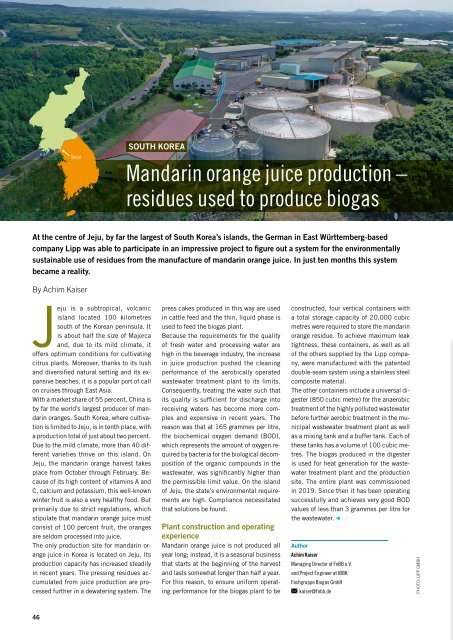Spring 2021 EN
The German Biogas Association presents its English spring 2021 issue of the BIOGAS journal.
The German Biogas Association presents its English spring 2021 issue of the BIOGAS journal.
Create successful ePaper yourself
Turn your PDF publications into a flip-book with our unique Google optimized e-Paper software.
English Issue<br />
Biogas Journal<br />
| <strong>Spring</strong>_<strong>2021</strong><br />
South Korea<br />
Seoul<br />
Mandarin orange juice production –<br />
residues used to produce biogas<br />
At the centre of Jeju, by far the largest of South Korea’s islands, the German in East Württemberg-based<br />
company Lipp was able to participate in an impressive project to figure out a system for the environmentally<br />
sustainable use of residues from the manufacture of mandarin orange juice. In just ten months this system<br />
became a reality.<br />
By Achim Kaiser<br />
Jeju is a subtropical, volcanic<br />
island located 100 kilometres<br />
south of the Korean peninsula. It<br />
is about half the size of Majorca<br />
and, due to its mild climate, it<br />
offers optimum conditions for cultivating<br />
citrus plants. Moreover, thanks to its lush<br />
and diversified natural setting and its expansive<br />
beaches, it is a popular port of call<br />
on cruises through East Asia.<br />
With a market share of 55 percent, China is<br />
by far the world’s largest producer of mandarin<br />
oranges. South Korea, where cultivation<br />
is limited to Jeju, is in tenth place, with<br />
a production total of just about two percent.<br />
Due to the mild climate, more than 40 different<br />
varieties thrive on this island. On<br />
Jeju, the mandarin orange harvest takes<br />
place from October through February. Because<br />
of its high content of vitamins A and<br />
C, calcium and potassium, this well-known<br />
winter fruit is also a very healthy food. But<br />
primarily due to strict regulations, which<br />
stipulate that mandarin orange juice must<br />
consist of 100 percent fruit, the oranges<br />
are seldom processed into juice.<br />
The only production site for mandarin orange<br />
juice in Korea is located on Jeju. Its<br />
production capacity has increased steadily<br />
in recent years. The pressing residues accumulated<br />
from juice production are processed<br />
further in a dewatering system. The<br />
press cakes produced in this way are used<br />
in cattle feed and the thin, liquid phase is<br />
used to feed the biogas plant.<br />
Because the requirements for the quality<br />
of fresh water and processing water are<br />
high in the beverage industry, the increase<br />
in juice production pushed the cleaning<br />
performance of the aerobically operated<br />
wastewater treatment plant to its limits.<br />
Consequently, treating the water such that<br />
its quality is sufficient for discharge into<br />
receiving waters has become more complex<br />
and expensive in recent years. The<br />
reason was that at 165 grammes per litre,<br />
the biochemical oxygen demand (BOD),<br />
which represents the amount of oxygen required<br />
by bacteria for the biological decomposition<br />
of the organic compounds in the<br />
wastewater, was significantly higher than<br />
the permissible limit value. On the island<br />
of Jeju, the state’s environmental requirements<br />
are high. Compliance necessitated<br />
that solutions be found.<br />
Plant construction and operating<br />
experience<br />
Mandarin orange juice is not produced all<br />
year long; instead, it is a seasonal business<br />
that starts at the beginning of the harvest<br />
and lasts somewhat longer than half a year.<br />
For this reason, to ensure uniform operating<br />
performance for the biogas plant to be<br />
constructed, four vertical containers with<br />
a total storage capacity of 20,000 cubic<br />
metres were required to store the mandarin<br />
orange residue. To achieve maximum leak<br />
tightness, these containers, as well as all<br />
of the others supplied by the Lipp company,<br />
were manufactured with the patented<br />
double-seam system using a stainless steel<br />
composite material.<br />
The other containers include a universal digester<br />
(850 cubic metre) for the anaerobic<br />
treatment of the highly polluted wastewater<br />
before further aerobic treatment in the municipal<br />
wastewater treatment plant as well<br />
as a mixing tank and a buffer tank. Each of<br />
these tanks has a volume of 100 cubic metres.<br />
The biogas produced in the digester<br />
is used for heat generation for the wastewater<br />
treatment plant and the production<br />
site. The entire plant was commissioned<br />
in 2019. Since then it has been operating<br />
successfully and achieves very good BOD<br />
values of less than 3 grammes per litre for<br />
the wastewater.<br />
Author<br />
Achim Kaiser<br />
Managing Director of FnBB e.V.<br />
and Project Engineer at IBBK<br />
Fachgruppe Biogas GmbH<br />
kaiser@fnbb.de<br />
Photo: LIPP GMBH<br />
46


















